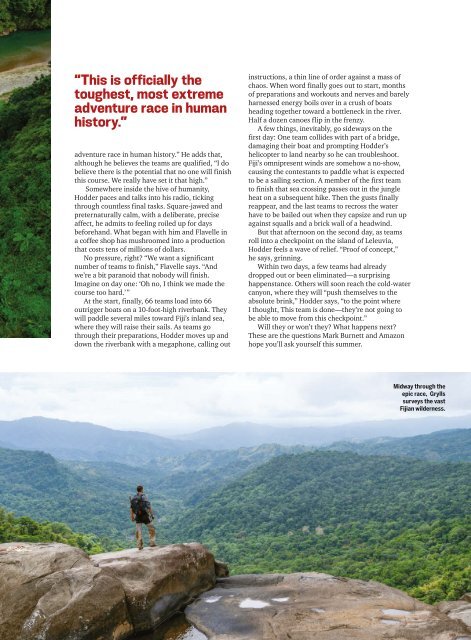Create successful ePaper yourself
Turn your PDF publications into a flip-book with our unique Google optimized e-Paper software.
“This is officially the<br />
toughest, most extreme<br />
adventure race in human<br />
history.”<br />
adventure race in human history.” He adds that,<br />
although he believes the teams are qualified, “I do<br />
believe there is the potential that no one will finish<br />
this course. We really have set it that high.”<br />
Somewhere inside the hive of humanity,<br />
Hodder paces and talks into his radio, ticking<br />
through countless final tasks. Square-jawed and<br />
preternaturally calm, with a deliberate, precise<br />
affect, he admits to feeling roiled up for days<br />
beforehand. What began with him and Flavelle in<br />
a coffee shop has mushroomed into a production<br />
that costs tens of millions of dollars.<br />
No pressure, right? “We want a significant<br />
number of teams to finish,” Flavelle says. “And<br />
we’re a bit paranoid that nobody will finish.<br />
Imagine on day one: ‘Oh no, I think we made the<br />
course too hard.’ ”<br />
At the start, finally, 66 teams load into 66<br />
outrigger boats on a 10-foot-high riverbank. <strong>The</strong>y<br />
will paddle several miles toward Fiji’s inland sea,<br />
where they will raise their sails. As teams go<br />
through their preparations, Hodder moves up and<br />
down the riverbank with a megaphone, calling out<br />
instructions, a thin line of order against a mass of<br />
chaos. When word finally goes out to start, months<br />
of preparations and workouts and nerves and barely<br />
harnessed energy boils over in a crush of boats<br />
heading together toward a bottleneck in the river.<br />
Half a dozen canoes flip in the frenzy.<br />
A few things, inevitably, go sideways on the<br />
first day: One team collides with part of a bridge,<br />
damaging their boat and prompting Hodder’s<br />
helicopter to land nearby so he can troubleshoot.<br />
Fiji’s omnipresent winds are somehow a no-show,<br />
causing the contestants to paddle what is expected<br />
to be a sailing section. A member of the first team<br />
to finish that sea crossing passes out in the jungle<br />
heat on a subsequent hike. <strong>The</strong>n the gusts finally<br />
reappear, and the last teams to recross the water<br />
have to be bailed out when they capsize and run up<br />
against squalls and a brick wall of a headwind.<br />
But that afternoon on the second day, as teams<br />
roll into a checkpoint on the island of Leleuvia,<br />
Hodder feels a wave of relief. “Proof of concept,”<br />
he says, grinning.<br />
Within two days, a few teams had already<br />
dropped out or been eliminated—a surprising<br />
happenstance. Others will soon reach the cold-water<br />
canyon, where they will “push themselves to the<br />
absolute brink,” Hodder says, “to the point where<br />
I thought, This team is done—they’re not going to<br />
be able to move from this checkpoint.”<br />
Will they or won’t they? What happens next?<br />
<strong>The</strong>se are the questions Mark Burnett and Amazon<br />
hope you’ll ask yourself this summer.<br />
Midway through the<br />
epic race, Grylls<br />
surveys the vast<br />
Fijian wilderness.

















